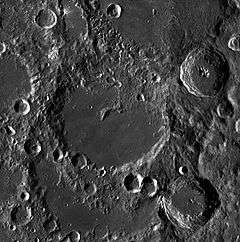Von Kármán (lunar crater)
|
LRO image | |
| Coordinates | 44°48′S 175°54′E / 44.8°S 175.9°ECoordinates: 44°48′S 175°54′E / 44.8°S 175.9°E |
|---|---|
| Diameter | 180 km |
| Depth | Unknown |
| Colongitude | 188° at sunrise |
| Eponym | Theodore von Kármán |

Von Kármán is a lunar crater that is located in the southern hemisphere on the far side of the Moon. The northern third of this formation is overlain by the rim and outer rampart of the walled plain Leibnitz, forming a deep indentation in the formation. The remainder of the outer wall is roughly circular in shape, although it is irregular and heavily worn by subsequent impacts.
The interior of Von Kármán has been subjected to flooding by lava flows after the original crater formed, leaving the southern portion of the floor nearly flat. This surface has a lower albedo than the surrounding terrain, and is nearly as dark as the interior of Leibnitz. There is a central peak at the location where the midpoint of the original Von Kármán was formed, which joins with the rougher surface in the northern part of the crater.
In addition to Leibnitz to the north, the crater Oresme is located to the west-northwest, and Finsen lies to the northeast on the edge of Leibnitz's rim. Nearly attached to the southeast rim is the unusual figure-eight-shaped Von Kármán L formation. Directly to the east of this is the crater Alder.
Prior to formal naming in 1970 by the IAU,[1] the crater was known as Crater 434.[2]
Satellite craters
By convention these features are identified on lunar maps by placing the letter on the side of the crater midpoint that is closest to Von Kármán.
| Von Kármán | Latitude | Longitude | Diameter |
|---|---|---|---|
| L | 47.7° S | 177.9° E | 29 km |
| M | 47.2° S | 176.2° E | 225 km |
| R | 45.8° S | 170.8° E | 28 km |
References
- ↑ Von Kármán, Gazetteer of Planetary Nomenclature, International Astronomical Union (IAU) Working Group for Planetary System Nomenclature (WGPSN)
- ↑ Lunar Farside Chart (LFC-1A)
- Andersson, L. E.; Whitaker, E. A. (1982). NASA Catalogue of Lunar Nomenclature. NASA RP-1097.
- Blue, Jennifer (July 25, 2007). "Gazetteer of Planetary Nomenclature". USGS. Retrieved 2007-08-05.
- Bussey, B.; Spudis, P. (2004). The Clementine Atlas of the Moon. New York: Cambridge University Press. ISBN 978-0-521-81528-4.
- Cocks, Elijah E.; Cocks, Josiah C. (1995). Who's Who on the Moon: A Biographical Dictionary of Lunar Nomenclature. Tudor Publishers. ISBN 978-0-936389-27-1.
- McDowell, Jonathan (July 15, 2007). "Lunar Nomenclature". Jonathan's Space Report. Retrieved 2007-10-24.
- Menzel, D. H.; Minnaert, M.; Levin, B.; Dollfus, A.; Bell, B. (1971). "Report on Lunar Nomenclature by the Working Group of Commission 17 of the IAU". Space Science Reviews. 12 (2): 136–186. Bibcode:1971SSRv...12..136M. doi:10.1007/BF00171763.
- Moore, Patrick (2001). On the Moon. Sterling Publishing Co. ISBN 978-0-304-35469-6.
- Price, Fred W. (1988). The Moon Observer's Handbook. Cambridge University Press. ISBN 978-0-521-33500-3.
- Rükl, Antonín (1990). Atlas of the Moon. Kalmbach Books. ISBN 978-0-913135-17-4.
- Webb, Rev. T. W. (1962). Celestial Objects for Common Telescopes (6th revised ed.). Dover. ISBN 978-0-486-20917-3.
- Whitaker, Ewen A. (1999). Mapping and Naming the Moon. Cambridge University Press. ISBN 978-0-521-62248-6.
- Wlasuk, Peter T. (2000). Observing the Moon. Springer. ISBN 978-1-85233-193-1.
